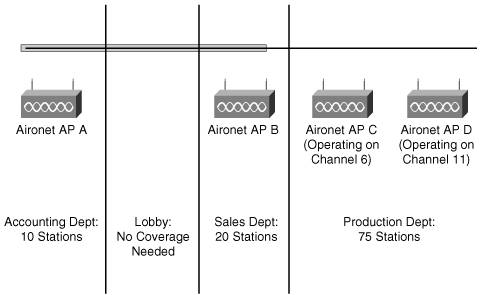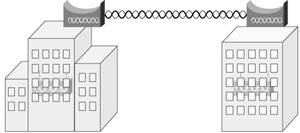Wireless Network Design Considerations
| To add a WLAN to your wired LAN requires you to think and plan before you affix access points (AP) to the ceiling and pass out wireless interfaces. This section gives some guidelines when you consider the variables involved in your WLAN design and integration. Establish Your Network's SizeThe first step is to establish the size of your WLAN. There are three elements you must consider when you plan for the size of your network:
You must strike a balance between the amount of APs you deploy and their placement in relation to the amount of stations that access them. In general, about 25 stations can access a single AP. Consider the WLAN shown in Figure 7-1. Figure 7-1. Plan for the Physical Size of Your Network and the Amount of Stations that Access the WLAN In this example, the organization is geographically dispersed and needs four APs to effectively cover its building. On the right side of the figure in the production area, 75 stations access the WLAN. Because of this, it is advisable to add a second AP. The sales and accounting departments are both served with one AP each. A lobby area is in the middle section of the building; however, it's not an area where WLAN coverage is needed. Therefore, no AP is located in that area. Note If stations in the accounting department shown in Figure 7-1 were difficult to reach with Category 5 cabling, you could locate an AP in the lobby area simply to serve as a repeater. Determining BandwidthYou must also determine how much bandwidth your network requires. Pay special attention to the density of users, along with normal per-user bandwidth needs. For instance, if you locate an AP in a conference room, expect many users to try to access the AP on the same channel, so you want a smaller cell size. If you locate APs in a warehouse where there are fewer users and a large space, larger cells are best served with high-gain antennas. Although it is necessary to know the number of users that use the AP, it's not the whole story. You must also factor in the bandwidth usage of your applications and how intense its use is. This is a hard number to quantify at the outset, and it's even more difficult to estimate for future applications. A good general rule of thumb: A single 802.11 channel can support up to 25 stations. Note Because there are so many factors at play with AP usage, WLANs are similar to wired LANs, and you must constantly keep on top of performance monitoring to find out if the WLAN is overburdened. Performance monitoring is covered in more depth in Chapter 12, "Network Tuning Tools and Resources." You should also consider the number of IP addresses needed for wireless devices, and how to dole them out. If you don't have enough IP addresses to go around, you can take some away from your wired LAN. Designing for Special NeedsWhen you design your WLAN, you must also take special needs and circumstances into consideration. There are numerous issues to balance, including your organization's needs, physical constraints, and antennas. Organizational NeedsFirst, you must take into account your organization's needs. That is, if there is a department or a section of the building that does not need WLAN coverage, don't worry about whether a signal propagates in that area. By the same token, if there are areas where you do not want coverage (for instance, maybe you don't want your WLAN signal to radiate outside the building), you need to think about that, too. The signal might still radiate outside the building, but to minimize that propagation is helpful. Of course, this isn't a foolproof means of security, but it is one more weapon in your security arsenal. For example, Figure 7-2 shows a campus set up. In this example, coverage is needed in both buildings. Although it would be nice for the employees to access the WLAN from the courtyard, it poses a point of access for potential attackers. Because of this, you do not want coverage in that area. Figure 7-2. Think About Where You Want Coverage and Where You Don't Want It Physical ConstraintsNext, consider the physical demands of your area. Perform a site survey to know what sort of range you can get from your equipment and where you need extra APs or antennas. If you determine exactly where to place APs for your respective cells, you can save a lot of time. First start with a copy of your building plans to make some preliminary estimates about coverage, based on distances and the office layout. (The presence of cubicles versus closed offices has an impact on range.) Whenever possible, locate your APs as close to your users as possible. Don't just draw coffee coaster circles on your map; think about where you need coverage. After you determine on paper where to place the APs, put your site survey skills to work. As you perform the site survey (flip back to Chapter 5, "Installing and Configuring Access Points," for more information on site surveys), you might also consider where you can run Ethernet cabling. Although APs can communicate with each other to extend the range of your WLAN, you still need to supply power to those devices. As such, you might consider APs that support power over Ethernet (PoE). Not only can you supply power to your APs, but you can also have a hardwired connection to the backbone to have a more reliable connection. AntennasIt is necessary to plan for antennas (which are discussed in Chapter 2, "Cisco Antennas"). Because most APs come equipped with omnidirectional antennas, the antenna broadcasts in a complete circle (three dimensionally, resembling a donut shape) around the antenna. This is great for cells in the middle of your office, but if the antenna is located in the corner of the room, the signal radiates into the wall, neighboring offices, or the parking lot. Note Also consider the alignment of your antenna and the three-dimensional world. If your antenna is positioned in such a way, it might radiate the signal through the ceiling or floor. If you locate an antenna against a wall or in a corner, consider a directional antennait not only reduces the signal's radiation into the neighboring lawyer's office, but it gets better range. Design ChecklistWhen you design your WLAN, use the following checklists to consider the special needs described in this section. Organizational Needs:
Physical Considerations:
Antennas:
|
EAN: 2147483647
Pages: 126

